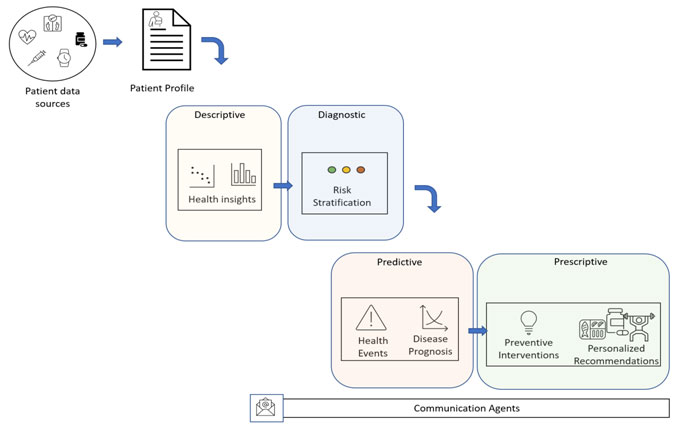It was nearly 7 PM on a warm summer day. George was sitting in his leaving room watching his favorite movie on the television. The movie was suddenly interrupted by a notification on his smart tv. The notification said, “George it is 7 PM it is time for your medication”. The notification also showed that George has taken his medication on time for 5 days in a row. George was tempted to dismiss the notification and get back to the movie but did not want to lose the streak. He got up when to his smart pill dispenser and consumed the medications.
James the physician for George was on his daily run when his smartwatch started buzzing. James took a break pulled out his phone and checked the notification. The system said there was the latest information available for George. James used his biometrics to authenticate and pulled the charts for George. The system showed him interesting insights into patient engagement and adherence. They had improved with the use of telehealth. James made a few more taps. The system had monitored vitals for George and re-stratified his risk from red to yellow. Some more taps and systems displayed a graph of predicted disease prognosis. The prognosis had changed from the previous review and now predicted better outcomes. James was satisfied with the progress. He keyed in words of encouragement for George and continued with his run.
AI-powered Telehealth had made healthcare delivery more dependable. Life is a little bit easier.
CDC defines Telehealth as follows “The use of electronic information and telecommunication technologies to support and promote long-distance clinical health care, patient and professional health-related education, public health and health administration.”
Telehealth and AI (Artificial Intelligence) are the most trending technologies in 2022. They have attracted billions of dollars in investment and seen a wide-reaching adaptation. Let us look at the key features, which make the synergy of Telehealth and AI so effective
Pandemic has brought telehealth to the forefront. We have discovered telehealth as a wonderful way to deliver healthcare remotely. Patients, Providers, and Regulators consider telehealth as a primary cog in healthcare. Now we use Personal health devices and the Internet of medical things (IoMT). We also have Improved connectivity with technologies like 5G. We can now collect, stream, and communicate copious amounts of data in real-time. AI complements telehealth to empower both care providers and patients. They use data and technology and move towards better outcomes.
Once Telehealth collects and organizes patient data AI models can provide more capabilities. These capabilities are Descriptive Models, Diagnostic Models, Predictive Models, Prescriptive Models, and Agents.
Descriptive Models
Descriptive models infuse traditional reporting with the power of AI. They analyze the data and correlations. They generate insightful reports that enable quick and informed decision-making. Consider an example where a patient is reporting variations in vitals. A Descriptive model can correlate steps, and sleep data. They can indicate the relation between reduced walking, irregular sleep, and variation in vitals.
Diagnostic Models
One of the most useful applications of Telehealth is to track patient risk in near real-time. Diagnostic models can identify conditions and risks by analyzing patient data. They are developed on standard rules, knowledge base, and training.
Key features – AI-powered Telehealth

Predictive Models
Telehealth also intends to monitor patients and avoid adverse health events from occurring. AI predictive models are trained on large samples of patients. They canpredict adverse health events that may occur and take necessary actions. Example – An AI predictive model can monitor the vitals of a patient and flag hospitalization in the next 7 days.Example – An AI predictive model may monitor the activity of a patient and predict a depression relapse. They can also predict the disease prognosis. This can enable care providers and patients to better manage the care delivery.
Prescriptive Models
A sophisticated AI model can not only predict but can also prescribe suggestions. When an adverse health event is predicted model suggests a set of interventions that could avert or manage the situation. They can also assist physicians in making treatment decisions. These models can analyze the patient data and make personalized recommendations. They can maximize the possibility of a positive outcome.
Agents
Agents refer to AI components that perform a specific task. Communication agents are one of the most common types of agents. Agents interface with systems like voice assistants, smart tv, phone, and smartwatch to communicate. Other types of agents can manage physicians’ virtual visit calendars. Chatbots are also greatly in use. Chatbots can answer frequently asked questions and interactively provide recommendations.
In conclusion, Telehealth powered by AI has the potential to transform healthcare delivery. They promise to deliver dependability and improved health outcomes. They are also our initial doorway to truly personalized healthcare of the future.



















